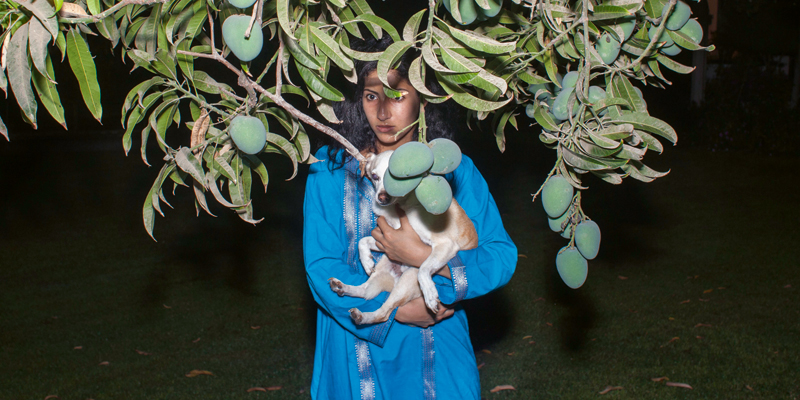And here’s what you need to know about their work.
Through outstanding artistic expression, Sophia Al Maria, Monira Al Qadiri and Farah Al Qasimi are making waves across the globe.
Collectively the three Gulf-born female artists explore themes based on their heritage and, through art they share their experiences of both growing up in the region and venturing abroad.
Through the mediums of photography, film, installation art and sculpture, the Middle Eastern artists have created a wave of interest within the contemporary art world, spanning from the East, and breaking onto the shores of the western art market.
Read:
The most stylish 48-hour staycations around the UAE
Four Tunisian models that need to be on your style radar
Farah Al Qasimi
Farah Al Qasimi explores themes of belonging, cultural diversity and the unusual in her art.
Born from an Emirati father and a Lebanese-American mother, Al Qasimi has spent time in both the UAE and the US. She initially enrolled to study music at Yale University, however during her studies she discovered photography and found she was able to express herself in new ways through this art medium.
Al Qasimi’s photography has been exhibited in Europe, the US and the UAE. Her recent shows include, the first Biennial for Arab Photography at l’Institut du Monde Arabe, Paris; Emirati Expressions at Manarat al Saadiyat, Abu Dhabi, two solo exhibitions at The Third Line, Dubai; The World is Sinking and Coming up Roses, a major commission at Alserkal Avenue, Dubai, and her first US solo exhibition at Helena Anrather, New York.
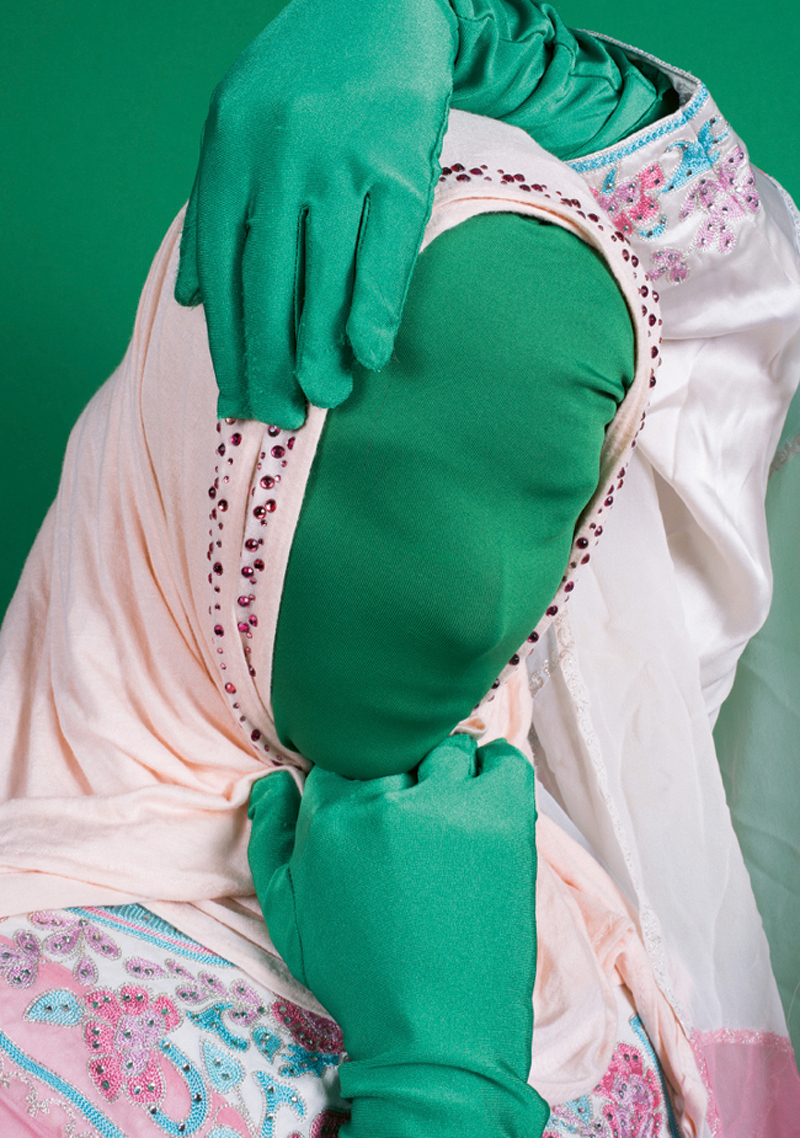
Al Qasimi’s approach to photography differs from the typical style of the medium. Her camera lens captures the unusual and enjoys challenging viewer’s expectations. Her 2017 commission at The Yard, Alserkal Avenue, Dubai, It’s Not Easy Being Seen, presents women who are invisible to the viewer.
Her subjects are covered by bright, green material that hides their identities, through the concept of a ‘green screen’. The green screen suggests someone can project something onto them which will make them disappear. Al Qasimi interrupts the viewers search for the soul by masking not only the eyes but the faces and bodies of her subjects. The artist toys with the idea that the women in her art want to be taken seriously, but this is impossible when they are covered in a fabric that makes them invisible.
Women play a significant role in her works, It’s Not Easy Being Seen and Coming Up Roses. Coming Up Roses was exhibited at The Third Line in 2016. In this body of work, Al Qasimi provides commentary on ideals of femininity, beauty and the universal quest for independence. In addition, the experience of women transitioning from childhood to adulthood is explored in Coming Up Roses.
With wit and satire, Al Qasimi expresses the unease of the moment in a young woman’s life when she is suddenly expected to look and behave differently to who she was as a girl. Through photography and film, Al Qasimi portrays the awareness of the gaze of others, whilst pairing these vulnerabilities with female strength, beauty and desire. The individuals in the works appear hypnotized in a world that is rich and colourful but is also dark and humorous.
Coming Up Roses has appealed to an international audience. Chiara Bardelli Nonino, the Vogue Italia photo editor nominating Al Qasimi for the British Journal of Photography, Ones to Watch. Chiara Bardelli Nonino states, “Al Qasimi’s constant displacement mirrors itself in her photographs in a powerful hybrid of Western and Arab aesthetics. By showing us her intimate vision of the world, her work familiarises us with a different concept of beauty.”

Farah Al Qasimi, Living Room Vape, More Good News, 2016.
In contrast, in the artist’s most recent solo exhibition More Good News at Helena Anrather, New York, Al Qasimi transfers over to the topic of male Arab depiction from the UAE to America.
Al Qasimi’s photographs subvert preconceptions and tackle cultural assumptions with humor and sympathy. In one photograph, two Emirati men greet one another by touching noses. The warm and traditional Gulf greeting, showcased in New York, brings the culture of her native UAE to the eyes of American viewers.
Other photographs in the exhibition present a hooded falcon, an Emirati man seated in his living room in a ball of shisha smoke, the back of a military man’s head with one hand on his shoulder and the shadow of turbaned man standing at a lectern. Again, the faces of Al Qasimi’s subjects are hidden from the viewer.
In the work, Ghaith at Home Al Qasimi photographs her friend. Ghaith is dressed in bright white, sitting on a white bed with a whitewashed background. Ghaith’s gaze is relaxed and looking downwards.
Al Qasimi draws a connection to the portrayal of women in portraiture from art history. For thousands of years, women have been shown with this reserved gaze, looking down, relaxed, calm. The shadow of a rose cast on the wall beside him underscores the feminine association. Al Qasimi presents her American audiences with an insight into the Arab male community and more than this, through the medium of photography, she is able to shape perceptions of her westerner viewers.
Al Qasimi has a beautiful, unique style of photography that gives pride to her Middle Eastern art enthusiasts and intrigues and interests her western audiences. She is able to express stories and meaning in such a way that gives sensibility to the art medium. Her exhibitions are able to narrate without characters locking eyes with the camera, and yet her subjects never lack personality. Al Qasimi’s look on the world shows the unusual and she is able to articulate and express what is unusual in societal and cultural preconceptions.
Sophia Al Maria
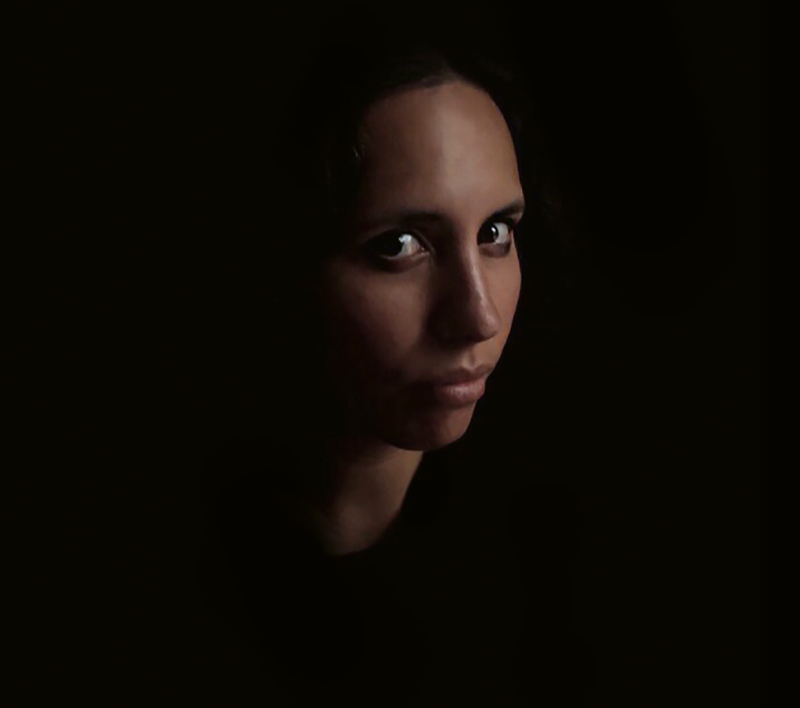
Sophia Al Maria, Artist portrait. Photo: Abdullah Al Mutairi.
Sophia Al Maria began her career studying comparative literature at the American University in Cairo, before continuing her education in aural and visual cultures at Goldsmiths, University of London.
Daughter of a Qatari Bedouin father and an American mother, Al Maria’s formative years were spent between Qatar and America and today she resides in the UK. Al Maria has grown into an internationally represented artist who is making news headlines in Miami, New York, Brussels and Beijing. Her work has enlightened, intrigued and captivated audiences across the globe.
Al Maria centralizes her themes around the topical debates of modernity. Her work brings consumerism culture and the digital age to the forefront of her artistic discussion. In just over five decades, the Gulf has seen one of the biggest leaps in economic growth from Bedouin simplicity to today’s skyscraper utopia.
For Gulf-born artists like Sophia Al Maria, Farah Al Qasimi and Monira Al Qadiri, the experience of the Mall has brought the fancies of the western world to the region and offered a new kind of public space. This addition to the region’s culture along with the rapid economic developments had an evident impact on their lives and artistic expression.
This extraordinary economic shift and digital experience has been labelled, ‘Gulf Futurism’, which is a term that was coined by Al Maria herself in her memoir, The Girl Who Fell to Earth (2012).
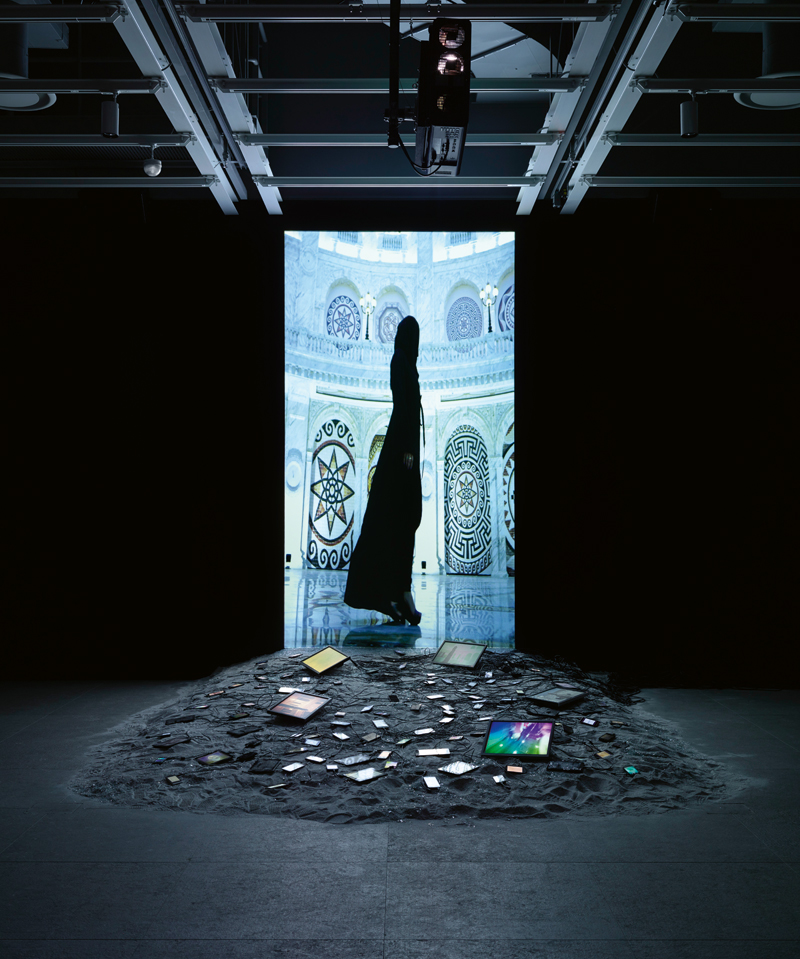
Sophia Al Maria, Black Friday, 2016, Digital video, color, sound 16.36min, Whitney Museum of American Art installation view.
Al Maria’s artworks and literature highlight the fruitful, chaotic and unsustainable nature of today’s consumerist culture. Al Maria’s ‘Gulf Futurism’ through art, film literature and voice has aroused international discussion, creating a tidal wave from the Middle East across the oceans to the West. The artist was featured comprehensively from UAE national newspapers to international magazines such as Dazed & Confused and Vice, to name a few.
In 2016, Al Maria showcased her Black Friday solo exhibition at The Whitney Museum of American Art. Through the medium of installation art and film, Al Maria presents the proposed utopic culture of the Gulf’s malls. She shines a light on the routine of shoppers in the region and drew parallels to America’s consumerist culture.
In the film, Maria infuses icons of western shopping culture with Islamic-tinged Italianate architectural motifs. Having spent time between the two, Al Maria observed similarities of routine, between the commitment of visiting your local mall and religious commitments. Black Friday presents the artist’s investigation into the act of purchasing as the 21st century’s religious rite.
It could be interpreted that the shoppers were devoting themselves to a new religion; capitalism and consumerism. The video includes slogans used by the US military combined with beauty product taglines, TV sets and mobile devices that flicker their transfixing screens and dark audio sounds. Highlighting the effects of technological advancements and the rise of social media, the film was shown in a dark room, with sand piled on the floor and mobiles mounted on top.
Closer to home, last year’s Everything Must Go was exhibited at The Third Line Gallery in Dubai. When entering the exhibition visitors were met with a room covered with brightly coloured, metallic local crisp packets, sprawling from supermarket trolley’s which have explored with consumer goods, scattered around the floor space.
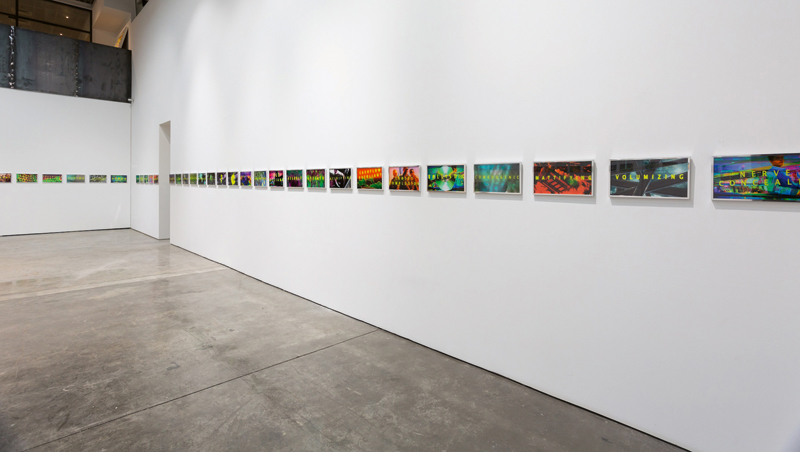
Sophia Al Maria, Everything Must Go, 2017, Installation
Amongst the piles of crisp packets, mobiles and tablets buzzed with indistinct sounds and incoherent voices. The heap centralised in the middle of the installation was surrounded by digital prints with threatening slogans, ‘panic’ and turned well-known beauty product names into fearful toxic monsters titled, ‘Teargas toner’, ‘Dirty Balm’ and ‘Post-Truth Plumper’.
From Black Friday to Everything Must Go, Al Maria has developed her artistic style and message towards an even more immersive experience.
In a year’s review, Al Maria’s intensified message reflects the progressive, unrelenting nature of modernity and speaks directly to a global audience. After all, 2017 grew its social media users by 160 million worldwide. As we exit what has been considered the technology age and enter into a new digital era, this number doesn’t look as though it will be slowing down any time soon.
From East to West, Al Maria’s artistic expression communicates the very real, chaotic and unsustainable nature of today’s consumerist culture. She comments on consumer habits, finding solace in the activity of purchasing and transfixing modes of technology.
All of which can be realised from the moment we finish reading this art feature, pick up the black mirror and check our social media accounts… before setting off to meet friends at the mall.
Monira Al Qadiri
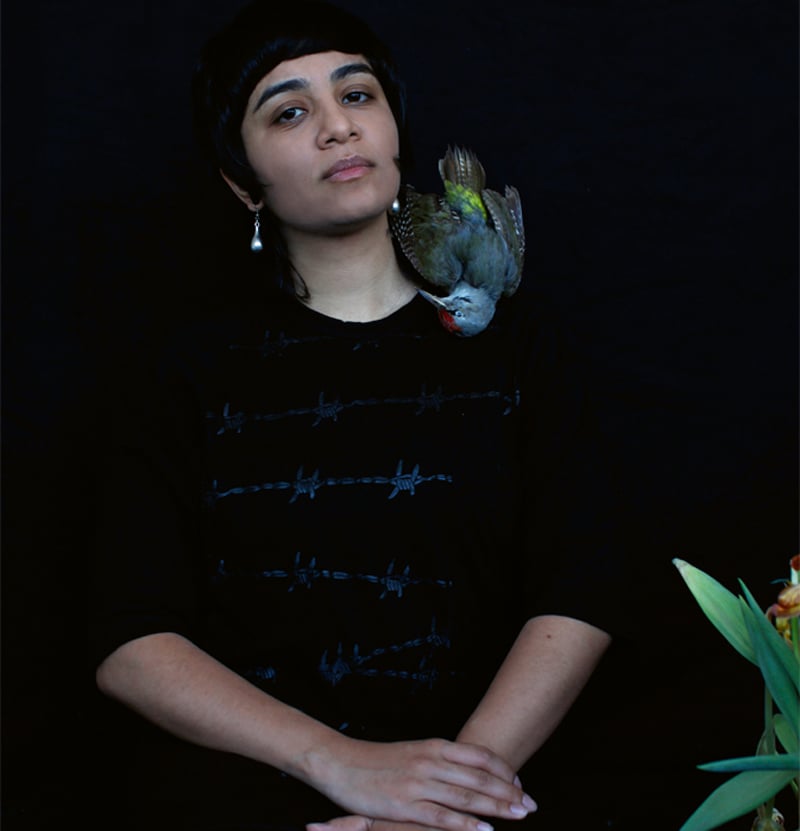
Monira Al Qadiri spent the majority of her early childhood indoors surrounded by all things colourful; toys, books, art, music and cartoons. Monira and her sister, Fatimi Al Qadiri spent months ‘protected’ (enclosed) in their home in Kuwait, away from the cruel brutalities of the Gulf War taking place around them.
For many people, art is a form of escapism, for Al Qadiri it was Japanese cartoons that offered refuge during her early years. Whilst a war was raging outside, Al Qadiri was engulfed in another animated world. Through their wild imaginary characters and their over exaggerated, high-energy voices Al Qadiri grew fascinated.
Growing a little older, she discovered her beloved Japanese cartoon characters were dubbed with Arabic voices by Lebanese actors. This initially stunned the artists who then became fascinated by the action of taking one culture and dubbing voices over another.
Fast forward two and a half decades and Al Qadiri has taken a project titled Feeling Dubbing to an international stage, showcasing her work at the international art festival Kunstenfestivaldes Arts in Brussels and Hamburg’s Theater der Welt.
Feeling Dubbing is a live performance, presenting a re-enactment of the Arabic dubbers, from the cartoon characters of her childhood. The theatrical art tells the stories of the dubbers; the Lebanese voice actors and the artist herself. The life-sized characters are animated and dramatized to create the same level of enthusiasm and over-excitable nature of cartoons.
The work is both funny and thought-provoking. Al Qadiri played herself in the performance, in puppet form. She found a strong emotional power in her Arabic voice acting, dressed as animated life-size characters the actors delivered a hyper energized persona behind the masks. It was as though the appearance didn’t matter as much, it was the theatre of voice that brought the magic, creating a surreal experience.

Monira Al Qadiri, The Craft, (2017) Video installation, Commissioned by Gasworks, London and the Sursock Museum, Beirut.
Japan is embedded in Al Qadiri’s own character. Out of her Japanese cartoon consumption, Al Qadiri grew a keen obsession with Japanese culture and at the early age of 16, she ventured to Japan to study and later completed her PhD in inter-media art at Tokyo University of the Arts. In total, she spent a full decade in Japan.
Initially, Al Qadiri felt isolated and outside of her usual habitat when arriving in Japan, the realities of her fantasies were replaced with a conservative culture that was restrictive for artists. From Kuwait to Japan, Al Qadiri reversed roles, and became the estranged cartoon character dubbed into the bewildering world of Tokyo.
Today, we see Al Qadiri’s work inspiring international art enthusiasts, guiding them through her past and into the future with a hypothetical eye.
In Al Qadiri’s film, The Craft, the idea of being alien is explored further. The artist reflects on a dream she had where she witnessed her mother step into a UFO, soon followed by her sister. Inside the UFO, she caught a glimpse of an American diner.
Al Qadiri was only 5 years old when she had this dream, during this time, her father worked for the Kuwaiti Government as a diplomat. On reflection Al Qadiri realized the connection she had made as an impressionable child, building her own understanding of her father’s profession, as a communicator with alien powers from across the world.
The Craft was exhibited as the centrepiece of her exhibition at Gasworks in South London and co-commissioned by Sursock Museum in Beirut. Logically, the artist featured the film inside the American diner from her dream, and on the back wall showed a film revolving around wild fictions mixed with suspicions towards the real world.
The experience was popular with its audiences for its capacity to transport visitors into American pop culture world, with visits from extra-terrestrial characters from her childhood.

Monira Al Qadiri, Feeling Dubbing, 2017.
Reflecting back on her Gulf heritage, Al Qadiri is proud of her project titled, Amorphous Solid. The piece involves a series of oil drill heads made of iridescent Murano glass. One of Al Qadiri’s key themes is pre-empting what is coming next.
The oil drill heads are metallic and mystical, and completely dysfunctional, this draws on the pre-empted future reality of oil running out. She expresses how her life revolved around oil, each significant moment of her life goes back to the lubricant, or as some Kuwaiti’s refer to as, the ‘magic potion’.
From the aircon in her family home to her Japanese scholarship, oil remains at the source. Yet this is met by the reality that oil has an expiry date. Al Qadiri jests that in years to come when archaeologists dig up the past they will come across her drill heads and other objects associated with the oil industry and categorize them as strange artefacts of the past. Highlighting the reality that in years to come oil will have run out and will be devoid of any meaning.
The first commission, Alien Technology, was a giant drill head placed in the public art space at the Shindagha Heritage Centre, in Dubai. This installation provided a beautiful juxtaposition from the grand metallic contemporary structure presenting the Middle East’s iconic symbol against the ‘old Dubai’ heritage backdrop.
Read:
Here’s your handy guide to this year’s Art Dubai
The 10 women from the Middle East we’ll be watching in 2018
Al Qadiri’s second giant oil drill head, Alien Technology II was commissioned by Mizna (Mizna is an organization devoted to promoting Arab-American culture, providing a forum for its expression) and co-presented with The Soap Factory, in Minneapolis, US. The work is presented at the Art Space within The Soap Factory and is there on view for all of 2018.
Al Qadiri is loved internationally for her ability to promote Arab-American culture and for her artistic skill to transport her viewers to other alien worlds. She translates magical and surreal experiences and offers audiences the chance to embark on an extraterrestrial journey, whilst mysteriously setting conspiracies and clues about the future along the way.
Words: Felicity Stokes
Images: Supplied
Main image: Farah Al Qasimi, Self-Portrait in Blue, 2015









